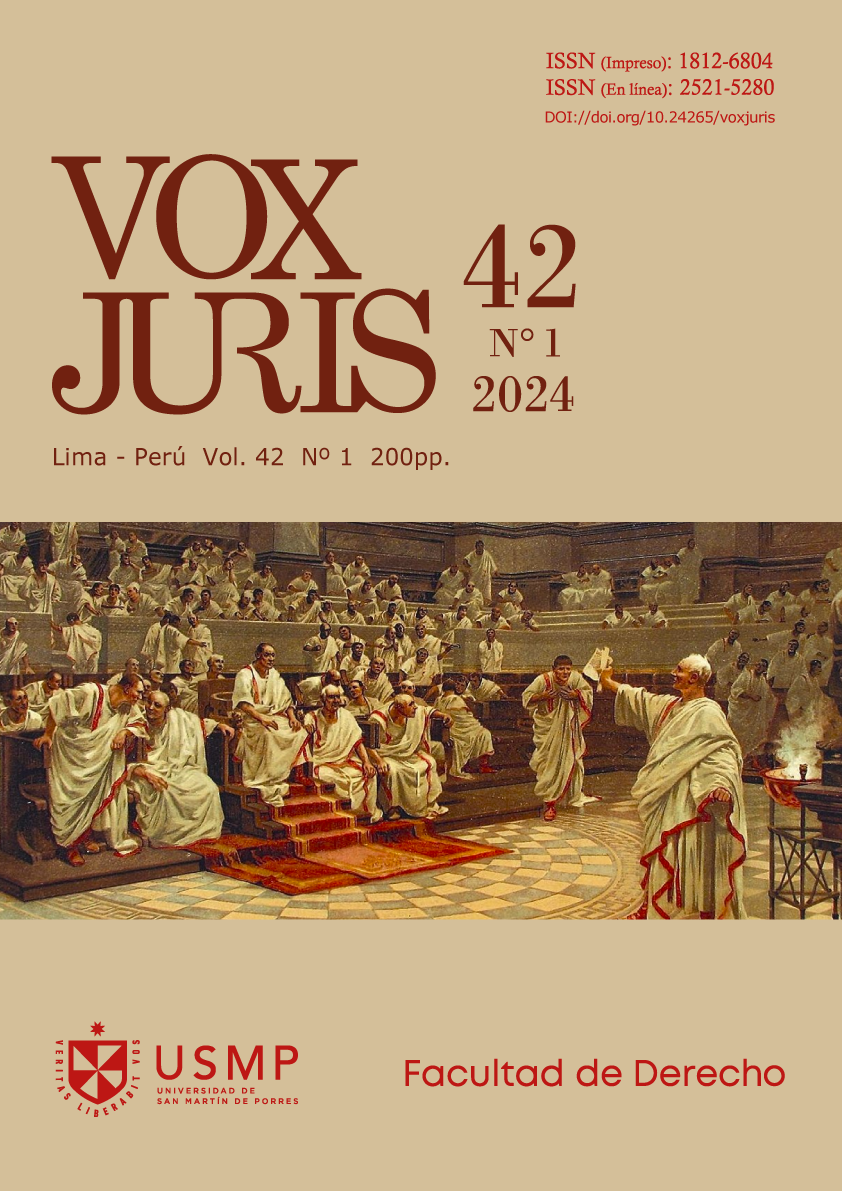THE VIABLE APPLICATION OF THE IMMEDIATE PROCESS FOR THE EFFECTIVE PROCESSING OF COMPUTER FRAUD CRIMES AND PROPOSALS TO CHILDREN AND ADOLESCENTS FOR SEXUAL PURPOSES THROUGH TECHNOLOGICAL MEANS IN THE JUSTICE SYSTEM
Abstract
This research work is based on the problems related to the increase in the number of registered complaints of computer crimes, which negatively affects the perception of citizen insecurity and the procedural overload in the justice system, there being a need on the part of the State to address this problem. In response to this, considering that data have been collected that demonstrate that the Immediate Process has obtained effective results in the justice system, the objective of this research work is to expose the viable application of the Immediate Process as an effective tool for the processing of the crimes of Computer Fraud and Proposals to children and adolescents for sexual purposes through technological means regulated by Law No. 30096 – Computer Crime Law. For this, the crime figures, procedural overload of the justice system, citizen insecurity and the growth of complaints for computer crimes are observed in order to show the problem to be addressed. Then an analysis of the Immediate Process is carried out, in addition, the results obtained in its application in the justice system are observed. Subsequently, an analysis of the crimes of Computer Fraud and Proposals to children and adolescents for sexual purposes through technological means is carried out. Finally, through an analysis of cases related to the aforementioned computer crimes, it is posible to expose the viability of the Immediate Process for the effective prosecution of these computer crimes.
Downloads
References
Ángeles, G. (2023). ¿Cómo reconocer un Yape falso? Consejos para evitar estafas. https://n9.cl/87d3j
Arévalo Vela, J. (2022). Plan de Gobierno 2023- 2024 Hacia una justicia de calidad con rostro humano en la era digital. https://n9.cl/z67xc
Cornejo, D. (2023). Clonan tarjeta del Metro de Lima con saldo de 4 millones de soles, pese a que el límite es de 100. https://n9.cl/oh9i7
Defensoría del Pueblo (2023). Informe Defensorial N° 001-2023-DP/ADHPD – La Ciberdelincuencia en el Perú: Estrategias y retos del Estado. https://www.defensoria.gob.pe/wp-content/uploads/2023/05/INFORME-DEF-001-2023-DP-ADHPD-Ciberdelincuencia.pdf
Donzis R. (2006). La eficacia social de las normas jurídicas. Revista electrónica de Teoría y Práctica de la Elaboración de Normas Jurídicas. 2(4), 6-24.
Franceza, F. (2016) La ley de flagrancia en debate. https://revistaideele.com/ideele/content/laley-de-flagrancia-en-debate
Instituto Nacional de Estadística e Informática (2023). Informe Técnico N° 01 – marzo 2023. https://acortar.link/WkeMWk
Instituto Nacional de Estadística e Informática (2023). Informe Técnico N° 01 – marzo 2023. https://acortar.link/WkeMWk
Ministerio de Justicia y Derechos Humanos (2020). Diagnóstico Situacional Multisectorial sobre la Ciberdelincuencia en el Perú. https://n9.cl/9t6tl
Ministerio de Justicia y Derechos Humanos (2020). Diagnóstico Situacional Multisectorial sobre la Ciberdelincuencia en el Perú. https://n9.cl/9t6tl
Ministerio de Justicia y Derechos Humanos (2022). Ciberdelincuencia – Reporte de Información Estadística y Recomendaciones para la Prevención. https://cdn.www.gob.pe/uploads/document/file/3562747/Reporte%20de%20Ciberdelincuencia.pdf.pdf
Ministerio de Justicia y Derechos Humanos (2022). Ciberdelincuencia – Reporte de Información Estadística y Recomendaciones para la Prevención. https://cdn.www.gob.pe/uploads/document/file/3562747/Reporte%20de%20Ciberdelincuencia.pdf.pdf
Ministerio Público – Fiscalía de la Nación (2021). Informe de Análisis N° 04 – Ciberdelincuencia en el Perú: Pautas para una Investigación Fiscal Especializada. https://n9.cl/cpi3z
Ministerio Público – Fiscalía de la Nación (2021). Informe de Análisis N° 04 – Ciberdelincuencia en el Perú: Pautas para una Investigación Fiscal Especializada. https://n9.cl/cpi3z
Ministerio Público Fiscal. (2021). Detienen y condenan en 48 horas a un groomer que contacto a una niña de 13 años de edad a través de una plataforma de juegos online. https://n9.cl/w20vv1
Miró Llinares, F. (2012). El Cibercrimen Fenomenología y criminología de la delincuencia en el ciberespacio. Marcial Pons.
Neyra, C. (2020). Hackers vulneraron plataforma del Bono Familiar Universal para apropiarse de dinero. El Comercio. https://elcomercio.pe/lima/sucesos/coronavirus-en-peruhackers-vulneraron-plataforma-del-bono-familiarpara-apropiarse-de-dinero-noticia/?ref=ecr
Nota de Prensa. (2016). Doctor Meneses Presenta Balance Sobre Procesos De Flagrancia. Poder Judicial. https://n9.cl/jwzvx
Pichihua, S. (2023). Conoce las modalidades de fraude informático más usadas para ciberdelitos en el Perú. Andina – Agencia peruana de noticias. https://n9.cl/4qyf7
Poder Judicial. (2022). A partir del 1 de julio inicia funcionamiento unidad de flagrancia impulsada por el Poder Judicial. https://www.gob.pe/institucion/pj/noticias/610733-a-partirdel-1-de-julio-inicia-funcionamiento-unidad-deflagrancia-impulsada-por-el-poder-judicial
Pulso Ciudadano (2023). Publicación N° 06. Percepción Contexto Económico / Evaluación de Gobierno / Problemas país / Covid-19 / Conflictos sociales. https://n9.cl/thzf6
Sala Penal Transitoria de la Corte Suprema de Justicia de la República (2021). Casación N° 1620-2017 - Madre de Dios
Salas Penales Permanente y Transitoria (2016). Acuerdo Plenario Extraordinario Nº 2-2016/CIJ-116, II Pleno Jurisdiccional Extraordinario de las Salas Penales Permanente y Transitoria.
Sánchez Velarde, P. (2022). Código Procesal Penal Comentado. Editorial Iustitia.
Unidad de Equipo Institucional del Código Procesal Penal (2017) Justicia Penal - El nuevo modelo Procesal Penal Peruano Proceso de Implementación ETI-PENAL 2017-I. https://n9.cl/0ncp6
Downloads
Published
Issue
Section
License
Copyright (c) 2023 Jean Paul Meneses Ochoa

This work is licensed under a Creative Commons Attribution 4.0 International License.
Los autores que publican en esta revista están de acuerdo con los siguientes términos:
- Los autores conservan los derechos de autor y garantizan a la revista el derecho de ser la primera publicación del trabajo al igual que licenciado bajo una Creative Commons Attribution que permite a otros compartir el trabajo con un reconocimiento de la autoría del trabajo inicial en esta revista.


